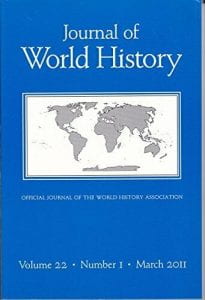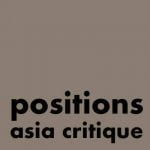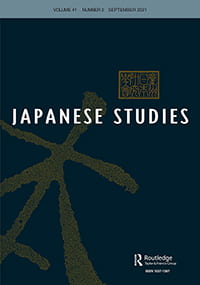ARTICLES
 “A Great Convergence: The American Frontier and the Origins of Japanese Migration to Brazil,” Journal of Global History, Volume 17, Issue 1 (March 2022), 109-127
“A Great Convergence: The American Frontier and the Origins of Japanese Migration to Brazil,” Journal of Global History, Volume 17, Issue 1 (March 2022), 109-127
This article explains how the US westward expansion influenced and stimulated Japanese migration to Brazil. Emerging in the nineteenth century as expanding powers in East Asia and Latin America, respectively, both Meiji Japan and post-independence Brazil looked to the US westward expansion as a central reference for their own processes of settler colonialism. The convergence of Japan and Brazil in their imitation of US settler colonialism eventually brought the two sides together at the turn of the twentieth century to negotiate for the start of Japanese migration to Brazil. This article challenges the current understanding of Japanese migration to Brazil, conventionally regarded as a topic of Latin American ethnic studies, by placing it in the context of settler colonialism in both Japanese and Brazilian histories. The study also explores the shared experiences of East Asia and Latin America as they felt the global impact of the American westward expansion.

“Eastward Ho! Japanese Settler Colonialism in Hokkaido and the Making of Japanese Migration to the American West, 1869-1888,” Journal of Asian Studies, Volume 78, Issue 3, (August 2019), 521-547
This article illustrates how Japanese colonial migration to Hokkaido in the first two decades of the Meiji era paved the way for Japanese trans-Pacific migration to the United States in the 1880s. It elaborates how Japanese leaders carefully emulated the Anglo-American settler colonialism in Japan’s own expansion in Hokkaido by focusing on the emergence of the overpopulation discourse and its political impact in early Meiji. This colonial imitation also inspired the Japanese expansionists to consider the American West an ideal destination for Japanese emigration in the late nineteenth century. This study thus challenges the nation-centered and territory-bound history of the Japanese empire by showing that Japan’s colonial expansion in Northeast Asia and Japanese trans-Pacific migration to North America were intertwined since the very beginning of the Meiji era.

“Japanese American Migration and the Making of Model Women for Japanese Expansion in Brazil and Manchuria, 1871- 1945,” Journal of World History, Volume 28, Number 3&4 (December 2017), 437-467
This article examines how the experience of Japanese American migration shaped the ways in which women were instrumentalized by the Japanese empire for its expansion in South America and Northeast Asia. The anti-Japanese sentiment and campaigns in the United States from the late nineteenth century to the early twentieth century greatly impacted the Japanese government’s approach to managing women’s role in Japan’s migration-driven expansion in Brazil and Manchuria during the following decades.
 “The Shame of Empire: Japanese Overseas Prostitutes and Prostitution Abolition in Modern Japan, 1880s-1920s,”positions: asia critique, Volume 24, Number 4 (November 2016), 839-873
“The Shame of Empire: Japanese Overseas Prostitutes and Prostitution Abolition in Modern Japan, 1880s-1920s,”positions: asia critique, Volume 24, Number 4 (November 2016), 839-873
This article examines campaigns aimed at abolishing Japanese overseas prostitution in Manchuria and North America during the late nineteenth century and early twentieth century, focusing on the ideologies and practices of Japanese middle-class abolitionists. It argues that campaigns for the eradication of Japanese prostitution abroad were driven by a desire to establish a civilized empire and cultivate a progressive Japanese racial self. The article also sheds light on the unexpected ways by which the abolitionists’ anxiety about—and their campaigns against—Japanese overseas prostitution had shaped Japan’s domestic prostitution abolition movement.
 “Colonizing Hokkaido and the Origin of Japanese Trans-Pacific Expansion, 1869-1894,”Japanese Studies, Volume 36, Number 2 (2016), 251-274
“Colonizing Hokkaido and the Origin of Japanese Trans-Pacific Expansion, 1869-1894,”Japanese Studies, Volume 36, Number 2 (2016), 251-274
This article argues that the Meiji government’s programs of colonial migration to Hokkaido established the intellectual foundation for the earliest wave of Japanese trans-Pacific migration to the US and colonial expansion in the South Pacific and Latin America between the 1880s and 1894. The experiences of migration-based colonial expansion and the trans-Pacific diaspora in modern Japan have been studied in isolation in existing literature. This article shows that these two experiences are actually inseparable from each other. The ideological origins of both were the migration-driven expansionism that emerged from the Meiji government’s colonial project in Hokkaido from 1869 to 1882.
 “Good Women for Empire: Educating Overseas Female Emigrants in Imperial Japan, 1900-1945,”Journal of Global History, Volume 8, Issue 3 (November 2013), 436-460
“Good Women for Empire: Educating Overseas Female Emigrants in Imperial Japan, 1900-1945,”Journal of Global History, Volume 8, Issue 3 (November 2013), 436-460
This article examines two tutelage campaigns launched by Japanese social reformers targeting Japanese emigrant women in Manchuria and California in the first two decades of the twentieth century. It reveals how these two middle-class-based social campaigns jointly paved the way for the Japanese state’s ‘continental bride’ policy in the late 1930s, which mobilized and exported women from across the nation to Manchuria on an unprecedented scale. Synthesizing the stories of Japan’s colonialism in Manchuria and Japanese labour migration to the American Pacific coast, this study traces the convergence and flows between the women’s education campaigns in Japanese communities on both sides of the Pacific. It moves the debate of Japanese imperialism beyond Asia and situates it in a transnational space encompassing the local, the national, and the global.

